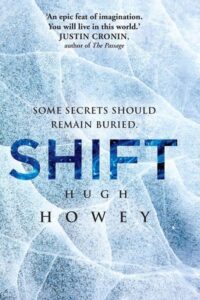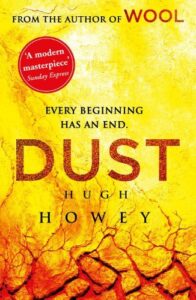I first read this series of three novels in late 2014, which was the first year that I had my Kindle e-reader. I seem to recall that at first I found the original short story, and then the collection that became the first full novel in Hugh Howey’s self-published Silo series, which at that time was titled, Wool Omnibus.
I’m not surprised that the series has continued to grow in popularity, or that it’s now a TV series (which I have not seen). I found it as gripping on this reread as I did the first time I encountered it.
I recommend that if you have not read this series and plan to, you only read my section on Wool at first, and come back if you wish to read the others, reserving each section of my post until you’ve read the prior book. I don’t want to spoil anyone’s initial experience of this amazing series.
WOOL
 Wool is a dystopian, post-apocalyptic tale, and begins with Holston, the sheriff of a large community living in a sealed up silo, climbing the central spiral stairs to his voluntary death, a death outside in a toxic environment, where he goes to clean the outside sensors that allow the people of the silo to have a view of the outdoors. As he climbs, he revisits memories of his wife Allison and discoveries she made before her death, in some restored computer files, about the history of the silo community. This provides a grim introduction to the world of the story, and then picks up with the mayor hiring Holston’s replacement, a woman mechanic named Juliette, who becomes the next sheriff, and the main character and hero of this installment in the series.
Wool is a dystopian, post-apocalyptic tale, and begins with Holston, the sheriff of a large community living in a sealed up silo, climbing the central spiral stairs to his voluntary death, a death outside in a toxic environment, where he goes to clean the outside sensors that allow the people of the silo to have a view of the outdoors. As he climbs, he revisits memories of his wife Allison and discoveries she made before her death, in some restored computer files, about the history of the silo community. This provides a grim introduction to the world of the story, and then picks up with the mayor hiring Holston’s replacement, a woman mechanic named Juliette, who becomes the next sheriff, and the main character and hero of this installment in the series.
We who love the genres talk a lot about world-building in science fiction and fantasy stories, but when you think about it, the world of a good story is not a static thing. It should never feel that way, it should be revealed along with the events of the story, and it should evolve as the characters do. I find Hugh Howey to be a master at this, at making the world of his story a character in itself, revealing its dark secrets to us a bit at a time, thoughtfully helping us see how it was before and how it continues to change, and how it could be. I sometimes love and sometimes hate the silo, it being both a home and a prison, with a stratified class system and the bonds of family and friendship coming in all varieties. I’m impressed by how well the author enables me to delve into its depths and feel as if I’m there, in his weirdly enclosed world, lending me the thankfully temporary experience of living in a silo.
I dreaded, just a little, revisiting the world of the silo, because I’m not always comfortable reading dystopian fiction, and there are grim events and villains and violence, but once I ventured within its pages, I found myself as much in the grip of this story as ever.
SHIFT
 If you’ve read Wool and found it too disturbing, then you don’t want to read Shift. I do recommend it for those with the stomach for it, and in fact this is one of my favorite science fiction series, not because of the disturbing content, but because of the resilience of some of the characters, and the human conflicts they come up against, as well as their human flaws and errors. Some of those errors are deadly, mind you, and I feel I should warn you that there’s a lot of violence in this series, and in this book the stakes get even higher. But it’s a thoughtful series altogether, and it’s that quality of making me think that I like best about it, aside from some favorite characters whose outcomes matter a great deal to me.
If you’ve read Wool and found it too disturbing, then you don’t want to read Shift. I do recommend it for those with the stomach for it, and in fact this is one of my favorite science fiction series, not because of the disturbing content, but because of the resilience of some of the characters, and the human conflicts they come up against, as well as their human flaws and errors. Some of those errors are deadly, mind you, and I feel I should warn you that there’s a lot of violence in this series, and in this book the stakes get even higher. But it’s a thoughtful series altogether, and it’s that quality of making me think that I like best about it, aside from some favorite characters whose outcomes matter a great deal to me.
The entire story of Wool (the first book in this series) takes place 300 years in the future, in two buried silos where generations of people have lived out their lives. That story leaves the reader wondering how these people got there, what their history was, and what apocalyptic event caused them to be there in the first place. The people of the silos don’t know. They don’t remember. They only know that one should never desire to go outside, that going outside is deadly.
This second book in the trilogy, Shift, explains what happened, how people got to be in these silos to begin with. It does so with a lot of shifts back and forth in time, and between points of view, and even some confusion of identities. The trouble all began in the mid-21st century.
That’s really as far as I want to go with the plot of the story. If you’ve read Wool and want to keep going with the story, you won’t want me feeding it to you. Just let me say, if you read Shift, you will find some answers to questions raised in Wool. Not all of them, because there has to be something left to learn and unravel in the last book of the trilogy.
This book makes one think about leadership, what it really is, and why we should all be suspicious of those who want to be leaders very badly, people who think they know best not just for themselves but for everyone, people who want control. It makes one think about how much control any one person or small group of people should have.
Shift also makes one think about the problems with freedom, especially with an attitude of rugged individualism. We as a species first survived and evolved in groups, in which we cooperated and took care of each other, and that still works best for humans. But in forming those groups we can distinguish too rigidly between our own group and other groups, when in fact we all need each other in order to keep humanity moving forward as a whole.
Last but not least, this book makes one think about technology, and how far it can or should go. Especially with AI currently taking off and a bit out of control, I think this is a timely story.
DUST
 This is the third and last book in the Silo series by Hugh Howey, and what can I say? It’s always intense toward the end of a series, when the stakes have built up and there are a lot of threads to tie together, and you need to find out what your favorite characters’ outcomes are, and whether the bad guys get their comeuppance. I’m no different from any other reader in that, once I’ve committed myself to a series.
This is the third and last book in the Silo series by Hugh Howey, and what can I say? It’s always intense toward the end of a series, when the stakes have built up and there are a lot of threads to tie together, and you need to find out what your favorite characters’ outcomes are, and whether the bad guys get their comeuppance. I’m no different from any other reader in that, once I’ve committed myself to a series.
But it’s also at this point in a series when I have trouble keeping track, in my mind, of where one book left off and the other began. Shift was full of shifts back and forth in time. But it also took a long look at the past, a past uprising in Silo 18, as well as what happened in Silo 17 that left Solo entirely alone from the time he was a boy to sometime in his late 40s when Juliette finds him there. By the end of Shift, time has caught up to the first book, Wool, a time 300 years after the silos came into use.
The question, in this third book is whether the people of Silos 17 and 18 will ever have a chance to learn what the world outside the silos is really like, whether it’s all a dead wasteland, or there’s something more beyond the silos, something worth venturing out to find. But first, Juliette wants to rescue the few people left in Silo 17, and she begins to dig through the lowest levels of Silo 18 in that direction.
 Back in Silo 1, Donald Keene, reawakened due to some mix-up in identities toward the end of Shift from a sleep he thought would be his last, has wakened his sister Charlotte, and they’re working together to try to help the people in the other silos survive Thurman’s deadly plan to eliminate all but one silo.
Back in Silo 1, Donald Keene, reawakened due to some mix-up in identities toward the end of Shift from a sleep he thought would be his last, has wakened his sister Charlotte, and they’re working together to try to help the people in the other silos survive Thurman’s deadly plan to eliminate all but one silo.
The drama all feels worth it by the end of this book, and I like the ending. The edition I read, which is actually all three books in one, ended with a series of three short stories that form a parallel series of events that meet up with the main series at the end, forming an even later epilogue. They don’t have to be read. The series is complete without them, and I kind of wish I hadn’t read them, because I would still have had my own imaginary continuation. But they’re an interesting read too.
Again, let me warn you this series is violent and intensely dramatic, with power plays and uprisings, murders and mass murder. Lots of political and human drama that gets intense and might not be the best thing to read if what you really need is something cozy and gently uplifting. But if you want intensity, you definitely get it here.